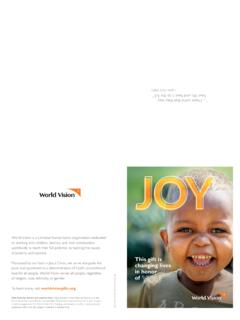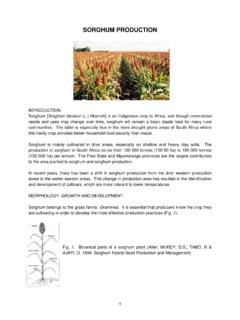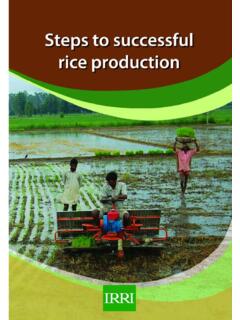Transcription of FARMING AS A BUSINESS (FAAB) MANUAL FOR …
1 FARMING AS A BUSINESS (FAAB) MANUAL FOR SMALLHOLDER FARMERSS econd Edition- Revised February 20182 FARMING as a BUSINESS (FaaB) MANUAL for Smallholder MANUAL is the second edition of FARMING as a BUSINESS (FaaB) MANUAL for Smallholder second edition of the MANUAL builds on the first edition developed by SNV in 2014. Original technical content, photographs and expertise for the MANUAL were provided by the ENSURE Livelihoods and Economic Development Te ch n i c a l Te a m .The production of this MANUAL was made possible through the generous support of the American people through the United States Agency for International Development (USAID). The contents of this report are the responsibility of the World Vision-led ENSURE food security program and do not necessarily reflect the views of USAID or the United States and Revision: Philip Goredema, Alex Popi, Honoured Moyo, Patson Makwiramiti, Abraham Muzulu.
2 Authur Masuka, Jane ZimbiruFunded By: by ENSURE, February 2018 World Vision, 2019 This publication may be freely reproduced for non-profit as a BUSINESS (FaaB) MANUAL for Smallholder of ContentsBackground ..5 MODULE 1. Creating a Commercial FARMING Mindset .. What Makes up your Farm BUSINESS ? .. How do you Explain the Following Changes in FARMING Practices? .. The Farm BUSINESS Cycle .. Explaining the BUSINESS Cycle using Nyere s Characteristics of a BUSINESS Person .. Important aspects of a farm BUSINESS ..13 MODULE 2. Overview of Farm Record Keeping .. What is a Record? .. Why Keep Records? .. Advantages of Record Keeping .. Consequences of Keeping Poor Records .. Types of Farm BUSINESS Records ..15 MODULE 3 Farm Enterprise Budgeting .. Introduction to Farm Budgeting? .. What is Farm Budgeting? .. Components of a Budget .. The Process of Budgeting.
3 Working Example: Prepare a budget!.. Examples of Enterprise Budgets .. Determining the Minimum Price and Yield for the Enterprise ..23 MODULE 4 Marketing and the Markets .. The Concept of Marketing .. Definitions .. Learning Points from Various Definitions .. Agricultural Marketing ..264 FARMING as a BUSINESS (FaaB) MANUAL for Smallholder Characteristics of Agricultural commodities .. Role of Marketing .. Types of Markets .. Elements of Marketing .. Marketing Constraints and Solutions .. Different Stages in Marketing Produce .. Together Each Achieves More .. Assessing Group Selling/Buying .. Market Survey Questionnaire ..35 ANNEXES ..435 FARMING as a BUSINESS (FaaB) MANUAL for Smallholder ENSURE (Enhancing Nutrition Stepping Up Resiliency and Enterprise) Program is a USAID-funded project implemented in Masvingo and Manicaland Provinces with the goal of improving household food security.
4 Purpose of this training initiativeThe main goal of this training MANUAL is to promote FARMING as a family BUSINESS for viable and sustainable food and nutritional security. This is done through imparting skills on commercial BUSINESS mindset, record keeping, enterprise budgeting, and marketing. The MANUAL will help farmers to learn and improve their BUSINESS knowledge, attitude and skills. Targeted participants need to be basically literate and numerate, but not necessarily formally educated, to use this MANUAL . In order to make more money from FARMING , farmers must take advantage of new opportunities, adapt their FARMING businesses to market changes, and improve efficiency and desire to increase income by taking advantage of market opportunities requires farmers to become better decision makers and better at competing in this new environment. The emphasis on the market and the need for farmers to be competitive calls for better farm management skills.
5 Farm management knowledge and skills help farmers to make the right choice between farm enterprises. 6 FARMING as a BUSINESS (FaaB) MANUAL for Smallholder 1. Creating a commercial FARMING mindsetThis module is designed to:i. Facilitate a smooth transition from subsistence FARMING towards commercial farmingii. Enhance an understanding of the nature of the FARMING Facilitate an understanding of a farm BUSINESS What makes up your farm BUSINESS ? (Brainstorm and present in a plenary discussion) How do you explain the following changes in FARMING practices? (Ask the participants to explain the changes) FARMING for FoodFarming for CashWhy This Change30 years ago10 years agoTo d ay7 FARMING as a BUSINESS (FaaB) MANUAL for Smallholder The farm BUSINESS cycle (Explain the BUSINESS cycle to the participants) Diagnosis and Finding Explaining the BUSINESS cycle using Nyere s storyPart 1: Diagnosis/finding opportunitiesAfter completing his secondary education, Nyere had left his village to seek a job in the city.
6 While the city life had been exciting and he had found several work opportunities, it had also been a hard living. Nyere s father was now too old to be managing the one acre family irrigation plot by himself, and Nyere was now happy to return home. However, he wanted to make sure that he would be earning enough to support his family on a long-term basis. For this, he needed to know the current FARMING practices and see what could be done to raise the income generated by the land. Upon return, Nyere started talking to the farmers in his own village, so that he could find out what crops were being grown in the area. He realized that most farmers were growing the same crops: beans, onions, and maize. When asked why, they said because everyone else did; it was what they had always grown. He also learned that these farmers were selling their produce to the first buyer who came to the a next step, Nyere decided to find out other products could be produced in the area.
7 He went to the nearest town where he talked to shopkeepers and traders, and found out that there was a high demand for garlic. Nyere knew that growing garlic was like growing onions, so it would not be difficult to produce. He also found three shopkeepers who said that they would buy garlic from him, provided it was of good quality. They said they normally paid $3 per kg. Before investing in garlic production , Nyere realized that he needed to know if he could make a profit by growing and selling garlic at the market rate. He visited a neighbouring village, where farmers helped him calculate how profitable garlic as a BUSINESS (FaaB) MANUAL for Smallholder a final step, Nyere approached a local extension worker who advised him to start garlic production by planting an acre with the new crop. The extension worker told him he should be able to harvest about 750 kg to 1000 kg per acre, so on acre, he should be able to produce between 190 and 250 kg of garlic.
8 After completing his investigations, Nyere decided to grow garlic on acre of his farm and plant beans, onions and maize on the rest of the questions:What did Nyere realise about the farmers in his village?What did Nyere decide to do?How did he do it? Why is this important?What did Nyere learn from his visit to the market (shopkeepers and traders)?What did Nyere decide to do?Why could he be confident about this?9 FARMING as a BUSINESS (FaaB) MANUAL for Smallholder 2: PlanningBased on what he had learnt from the market, the other farmer sand from the extension worker, Nyere set himself a goal of growing acres of garlic and marketing it to the three nearby shopkeepers. He figured out that if he sold 250 kg of garlic, he would obtain a total sales income of $750. But in order to calculate the profit he could make, he first needed to know the costs of the inputs that would be used to grow and sell the listed the primary inputs he would need to grow the garlic ( seed , fertiliser, pesticides, labour, small net bags in which the garlic would be packed, etc.)
9 He also factored in the cost of transporting the garlic from his farm to the shops. He calculated that all these inputs would cost him $160, meaning that he could expect a total profit of $590 from garlic course, Nyere now needed to implement his plan: buy the immediate inputs, organise labour, prepare his land and plant the crop. Also, when the crop was ready, he also had to organise its packing and question:Describe Nyere s planPart 3: Implementing: Organizing, Producing and MonitoringWhen Nyere had organised all the inputs, he prepared his land and planted the garlic seeds. Within a month, however, Nyere realised that the germination was poor and the growth of the garlic was not as expected. He went to the extension worker for advice, who told him to replant using a different variety of seed . Even though this was an extra cost for Nyere he obtained new seeds for planting, knowing that he had made a promise to several buyers in the market to supply good quality garlic.
10 He did quick calculations and knew that he would still make a that the crop would now be delayed by at least a month, he made new arrangements for transport. This did not cost him anything extra. The second time, the germination was much better. A few weeks later, Nyere s garlic was almost ready and it was looking to harvest time, Nyere bought the packaging he needed to market his garlic to the three shops. Very shortly thereafter, Nyere harvested his garlic. He was a month later than expected, but it was worth questions:What happened after Nyere planted his garlic?What did he do about it? Why?10 FARMING as a BUSINESS (FaaB) MANUAL for Smallholder it got close to harvesting time, what did Nyere do? Part 4: Implementing: marketingAs the garlic was harvested from the field, it was checked and cleaned. The bad cloves were thrown away, while the rest was packed into the net bags and put into boxes.



